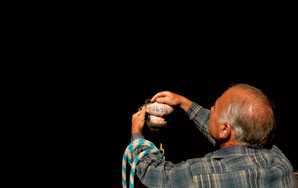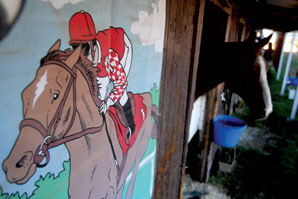For most people, horse racing means spending a few days at the fairgrounds’ track punctuated by the starting bell, thundering of hooves and the cheers or frustrated sighs from an expectant crowd.
But outside the distance between the starting gates and the finish line is a lifestyle built around the athletic equines, one that runs on a continuous loop of finding, training and running elite animals.
On Aug. 19, two days before horse racing returned to Kalispell for the first time since 2005, owners and trainers gathered at the racing barns on the Flathead County Fairgrounds to continue the incessant task of caring for their horses.
“You live, you breathe horses,” trainer and owner Debbie Cunnington said. “Your reward is when they cross that finish line.”
“You give up a lot as far as personal time,” she said.
 |
|
Tom Reed shows the tattoo under the upper lip of one of his racehorses at the Flathead County Fairgrounds. Most breeds of horses racing are required to have a lip tattoo for identification. |
Cunnington didn’t have a lot of time to talk; she needed to rotate her horses out of the stalls so she could replace the sawdust while the animals walked in circles led by metal walkers. This year’s racing co-director Janis Schoepf was also busy with horses at the barn, some belonging to her and others to clients.
Schoepf trains horses, but doesn’t breed or raise them. And though she was thoroughly occupied with making sure last weekend’s races were in line, Schoepf had already been thinking about the Pacific Coast Quarter Horse Racing Association’s sale in Los Angeles this October.
With up to 1,000 head of horses to choose from, Schoepf and her clients have already begun shopping.
“That’s the start,” Schoepf said.
Racehorses are typically purchased at a young age; Schoepf will buy long yearlings, meaning they are almost 2 years old. Once they hit the 2-year mark, their owners can start training them, she said.
The young horses will start going through their paces in January, and once they are physically ready, they need 120 days to learn about starting gates and races, Schoepf said.
“And that’s just one,” Schoepf said. “You can imagine anytime you have a barn-full, it’s 24-seven.”
Local racer Tom Reed knows just how detailed this process can be. He bought his horse, Florida Rock, in 2007 when it was 4 months old.
“It’s almost like I bred him,” Reed said.
When the horse was old enough, Reed had a trainer take a month to break it. Florida Rock was galloping by the time the trainer finished. But when Reed entered the horse in a race last year, it refused to run.
After a tendon injury sidelined training for a while, Florida Rock got back into the sport four and a half months ago. Reed’s horse entered its first race last week.
Even then, Florida Rock had more to learn. The horse had to get comfortable getting saddled and led to the paddock, as well as having its top lip lifted so race officials can see his identifying tattoo.
“He’s ready; he is bred to be a good horse,” Reed said.
While the Kalispell races brought the sport back to the Flathead Valley, local racers have spent the last few years elsewhere in pursuit of prize money.
 |
|
A fabric banner depicting a racehorse and rider is seen pinned to the side of the racehorse stables at the Flathead County Fairgrounds. |
Most of the racers are part of a larger circuit of races that happen in other parts of the state, Idaho, Washington and Canada. Kalispell and Missoula were added to the Montana circuit this summer, much to the delight of Montana Board of Horseracing Chairman Al Carruthers.
“We’re trying to revive horseracing in the whole state,” Carruthers said.
Kalispell was an especially exciting revival, he said, because it is the last track in the state that can handle all racing distances for quarter horses.
Ideally, Carruthers would like to see two or three weekends of horse racing in Kalispell instead of the current two-day spread, which he said could be a turnoff for non-local competitors.
“These guys don’t like to come all this distance for two days,” Carruthers said.
When the racers do come to the valley, they bring their families and their money, he said. They need places to stay, fuel, feed and things to do when they aren’t at the barns.
“The impact is unreal,” Carruthers said. “And from the looks of Kalispell, they need help.”
If the county agreed, Kalispell could potentially host races sponsored by the American Quarter Horse Association, he said. The races would take three weeks, because the AQHA requires two weeks between trial races and the finals.
The horse racing season usually runs through October. Then, when the weather cools the tracks, the equines are turned out to pasture and spend time “just being horses,” Cunnington said.
But racers don’t idle for long. Reed has other horses to train back on his 300-acre ranch south of Kalispell and he plans to wean a promising, new colt in the middle of October and raise it until it’s 2 years old and ready to break.
“He’s a nice colt,” Reed said.